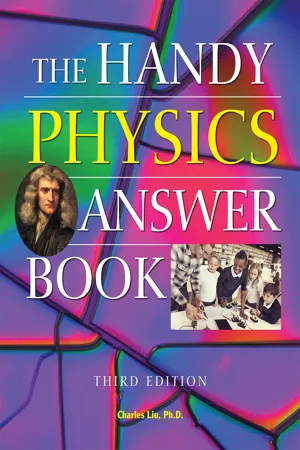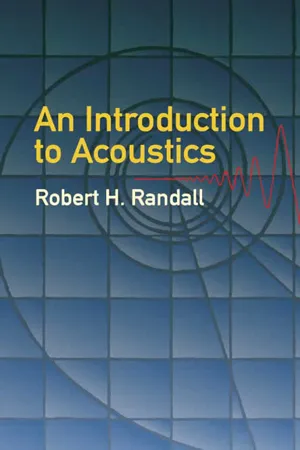Physics
Amplitude of Wave
The amplitude of a wave refers to the maximum displacement of a particle from its equilibrium position as the wave passes through it. In simpler terms, it is the height of the wave from its resting position to its highest point. The amplitude of a wave is directly proportional to the energy it carries.
Written by Perlego with AI-assistance
Related key terms
Related key terms
1 of 4
Related key terms
1 of 3
4 Key excerpts on "Amplitude of Wave"
- eBook - ePub
- Michael M. Mansfield, Colm O'Sullivan(Authors)
- 2020(Publication Date)
- Wiley(Publisher)
13.6 .We have defined measurable quantities which can be used to characterise a wave motion. Our next task is to derive an equation which relates these quantities for the type of wave motion that is produced by a source which is oscillating with simple harmonic motion. We will then be able to predict the disturbance produced by the wave at any position and time.Although we shall illustrate wave phenomena by considering wave motions with a wide variety of origins in nature, the description which will emerge may be applied to any type of wave motion. Light waves are an example of transverse electromagnetic waves; electromagnetic waves in general will be discussed in Chapters 21 and light in particular in Chapter 22 . In this chapter electromagnetic wave phenomena will be used occasionally as examples of wave phenomena.13.2 Representation of a wave which is travelling in one dimension
As waves pass through a medium along the x‐axis, the disturbance y, which can be either transverse or longitudinal, varies with both position, x, and time, t; it can therefore be written as a function of these two quantities, that isy = y(x, t).In order to determine the form of the function y(x, t) let us consider a wave in a taut string which is generated by a source which is oscillating with simple harmonic motion. The source could, for example, be a mass oscillating at the end of a spring, as considered in Section 3.6 . Sinusoidal waves will be propagated along the string, as illustrated in Figure 13.7 .A sinusoidal wave along a taut string, as observed at time t (solid line) and at an earlier time (Figure 13.7t − t0 ,dashed line).We already have an equation which gives the disturbance of the string atx = 0.This is the equation of simple harmonic motion (Equation (3.7a) ). Atx = 0, y(x, t - eBook - ePub
- Charles Liu(Author)
- 2020(Publication Date)
- Visible Ink Press(Publisher)
Note that if the frequency of a wave increases, the wavelength decreases; the velocity of that wave, however, is a property of the medium (rope) and doesn’t change. In other words, the frequency and wavelength of a wave are inversely proportional to each other.On what does the amplitude of a wave depend?
The amplitude depends on the amount of energy that the source of the wave puts into the wave. For example, the amplitude of a transverse wave in a rope depends on how hard you shake it. For a sound wave, it depends on how much compression the loudspeaker or musical instrument creates. The amplitude of a wave does not depend on its frequency, wavelength, or velocity.Does the amplitude of a wave depend on its distance from the source?
The energy carried in a wave depends on the wave’s amplitude and its velocity. Waves can be put into two general categories: those that spread, like water waves on a pond, sound waves, or electromagnetic waves; and those that are confined to a narrow region, like waves on a rope or electrical oscillations on a wire. A water wave spreads on the surface of a pond, lake, wide river, or ocean. As it spreads, its energy is spread over an increasingly large area, so the energy transmitted to a particular location is reduced when the source is farther away. Therefore, the amplitude of the water wave is also reduced in proportion to the distance from the source. Sound and electromagnetic waves usually spread in two dimensions. Again, as they spread, the energy carried is also spread, so as the distance from the source is increased, the amplitude is decreased, but this time as the square of the distance.On a rope or wire, the wave doesn’t spread. A different mechanism often reduces the amplitude. In a rope, there is friction between the fibers, which changes some of its kinetic energy to thermal energy. If a signal is sent through a wire as an oscillating voltage, the resistance of the wire will convert some of the electric energy to thermal energy, reducing the voltage and thus the amplitude of the wave. This loss can be reversed by placing amplifiers along the wire, which can put more energy into the wave and increase its amplitude. - eBook - ePub
- Marshall Long(Author)
- 2014(Publication Date)
- Academic Press(Publisher)
characteristic impedance . For air at room temperature it is about 412 mks or 41 cgs rayls.Intensity
Another important acoustical parameter is the measure of the energy propagating through a given area during a given time. This quantity is the intensity , shown in Fig. 2.18 . For a plane wave it is defined as the acoustic power passing through an area in the direction of the surface normal:E = energy contained in a sound wave (N m / s) W = sound power (W)(2.48)whereI (θ) = intensity (W / m 2 ) passing through an area in the direction of its normalS = measurement area (m 2 )T = period of the wave (s) θ = angle between the direction of propagation and the area normal (rad)The maximum intensity, I, is obtained when the direction of propagation coincides with the normal to the planar surface, when the angle :(2.49)Plane waves are the most commonly analyzed waveform because the mathematics are simple and the form ubiquitous. A wave is considered planar when its properties do not change in the plane whose normal is the direction of propagation. Intensity is a vector quantity. Its direction is defined by the direction of the normal of the measurement area. When the normal is oriented along the direction of propagation of the sound wave, the intensity has its maximum value, which is not a vector quantity.Figure 2.18 Intensity of a Plane WaveSound power is the sound energy being emitted by a source each cycle. The energy, the mechanical work done by a wave, is the force moving through a distance:(2.50)where p is the root-mean-square acoustic pressure, and S is the area. The power, W, is the rate of energy flow so(2.51)where u is the velocity of a small region of the fluid, and is called the particle velocity. It is not the thermal velocity of individual molecules but rather the velocity of a small volume of fluid caused by the passage of the sound wave. For a plane wave(2.52) - eBook - ePub
- Robert H. Randall(Author)
- 2012(Publication Date)
- Dover Publications(Publisher)
Fig. 2–5 , shows a sort of pseudoquantum nature, regions of large total energy alternating with regions of little or no energy. In the case of traveling transverse waves on a stretched string, the above remarks do not apply. For these waves, as will be seen in Chapter 7, the kinetic energy maxima and the potential energy maxima are not coincident.FIG. 2–5 . Graph of energy distribution along x at a given instant of time.2–18 Sound intensity.
This important measure of sound wave amplitudes is defined as the energy flow across an area, per unit area and per unit time. This energy will plainly be equal to that contained in a column of unit cross section and of length c , the velocity of sound. Therefore the intensity I is the product of the total energy density, derived above, and the velocity c .There are several different ways of writing the expression for the sound wave intensity, in view of the interrelations between all the important parameters. Several useful forms, whose validity are given below.(2–29)The form given in Eq. (2–29c) is algebraically similar to the expression for electrical power, RI 2 , where p 0 c replaces R and takes the place of I . Extensive use of this analogy will be made in Chapter 5.2–19 Units of intensity.
Using cgs units, intensity is measured in ergs-cm–2 -sec–1 . For ordinary audible waves, intensities range from about 10–9 to about 10+3 cgs units. In mks units this corresponds to a range of from 10–12 to 1.0 joule-meter–2 -sec–1 . These numbers are an indication of how small are the energies associated with sound. The total energy coming from the throats of a crowd at a football game, in response to some spectacular play on the field, might perhaps be enough to heat a cup of coffee! Even the great crescendos of a large symphony orchestra involve very little sound wave energy. All of this is a tribute to the sensitivity of the human ear.2–20 The decibel.
For two sounds of intensities I 1 and I2 , one is said to be of a greater intensity than the other by a number of decibels (db), where(2–30)The decibel is therefore not an absolute, but a comparative measure of intensity and is consequently a pure number. Without the factor 10, the comparison is in bels,
Index pages curate the most relevant extracts from our library of academic textbooks. They’ve been created using an in-house natural language model (NLM), each adding context and meaning to key research topics.
Explore more topic indexes
Explore more topic indexes
1 of 6
Explore more topic indexes
1 of 4



